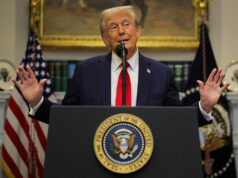
WASHINGTON – Republicans in the U.S. Congress turned in earnest on Monday to their biggest challenge of Donald Trump’s presidency: trying to bridge internal divisions over proposed cuts to Medicaid and popular green energy initiatives to pay for a landmark tax-cut bill they hope to enact by July 4.
After a two-week recess marked by some heated encounters with constituents back home, Republican lawmakers in the House of Representatives were due to hold committee votes this week on segments of Trump’s agenda legislation.
“The House is moving things along quickly and the Senate is in lockstep. We think that they are in substantial agreement,” Treasury Secretary Scott Bessent told reporters after a closed-door meeting with Republican House Speaker Mike Johnson, Republican Senate Majority Leader John Thune and tax committee chairs.
“We hope that we can have this tax portion done by the Fourth of July,” he added, referring to legislation that would also fund Mr. Trump’s crackdown on immigration and bolster fossil fuel production and the military.
The top goal for Republicans, who control the House and Senate, is to extend provisions of Mr. Trump’s 2017 Tax Cuts and Jobs Act that are due to expire at the end of this year, a move that nonpartisan researchers estimate would cost $4.6 trillion over a decade.
Mr. Bessent said the forthcoming bill would also eliminate taxes on tips, overtime pay and Social Security benefits, allow for the deductibility of auto loans and include 100% expensing for equipment and factory structures. Those measures would add to the bill’s cost.
Add in hundreds of billions of dollars in new spending for border security, deportations and defense, and the cost to the U.S. budget could skyrocket.
The budget blueprint for Mr. Trump’s agenda could add $5.8 trillion to the current $36 trillion U.S. debt in the next decade, the nonpartisan Committee for a Responsible Federal Budget estimates. Republicans say the cost will be covered by a combination of spending cuts, higher economic growth and revenues from energy deregulation and tariffs on imports.
Congress needs to complete the bill before the debt reaches a mandated borrowing limit sometime later this year. Bessent said tax revenues are ahead of last year and that an accurate “X-date” projection for when the Treasury Department will be unable to meet all its obligations could be available within the next two weeks.
With a Republican majority of 220-213 seats in the House and a 53-47 advantage in the Senate, it is not clear that House Republicans can meet Johnson’s aim of passing the legislation and sending it on to the Senate before lawmakers leave town on May 22.
House and Senate Republicans barely managed to pass a budget resolution that will allow them to enact the Trump agenda by circumventing Democrats, who have nonetheless vowed to halt Trump’s legislative juggernaut.
“We’re in active legislative combat,” House Democratic leader Hakeem Jeffries said at an event in New York City.
“They want to enact the largest Medicaid cut in American history. That is going to hurt families, hurt children, hurt seniors, hurt people with disabilities, hurt everyday Americans.”
NOW COMES THE HARD PART
The budget blueprint contained no details about spending cuts. Now Republican lawmakers must grapple with changes that carry tangible consequences for their home districts.
“It probably takes a little longer to get it out of the House,” Republican Representative Nicole Malliotakis said. “We’re not just talking about the broad strokes here. We’re talking actual legislative language, actual numbers.”
To win support from hardline conservatives, House Republicans set a spending cut target of $2 trillion over a decade and agreed that the scope of Mr. Trump’s tax cuts would be scaled back to reflect any shortfall in funding reductions.
But with House and Senate moderates pushing back on deep cuts to social safety-net programs and environmental initiatives, some worry the $2 trillion goal could be out of reach.
“That is the biggest challenge, getting that to the sweet spot where we have enough significant and noteworthy spending cuts to finalize the tax side,” said Representative Blake Moore, vice chair of the House Republican Conference.
Up to now, Republicans have looked to the Medicaid healthcare program for lower-income Americans and green tax credits for $880 billion in spending cuts over a decade. Education and agriculture programs have been targeted for an additional $560 billion in cuts.
But concerns about Medicaid among a dozen House Republicans and several Senate Republicans have prompted Mr. Trump and party leaders to assure lawmakers that savings will not lead to cuts in benefits.
Those assurances have reduced fears about major cuts in the federal contribution to Medicaid, which is funded jointly by federal and state governments. More than 79 million Americans were enrolled in the program or a related healthcare service for poor children as of October. — Reuters



